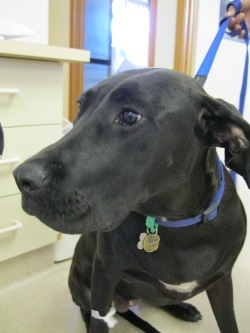Hip dysplasia (HD) is a painful disease that can cause lameness in puppies from less than a year of age. Hip dysplasia refers to abnormal development of the hip joint. It is a genetic disease (inherited) but is also influenced by other factors including diet and rate of growth. This is Morgan the 9 month old Great Dane–Ridgeback cross who has been diagnosed with HD. Large and giant breeds of dogs are more frequently affected including Labradors, Golden Retrievers, and Rottweilers. Signs include lameness, reluctance to jump up, reduced exercise tolerance, and sometimes a ‘bunny hopping’ gait . In mild cases, signs may appear after several years due to arthritis (Degenerative Joint Disease).
Diagnosis is by a veterinary exam and x-rays taken under anaesthesia.Treatment involves surgery or conservative measures. Surgical options are varied and include hip replacement and excision of the hip. Conservative treatment includes prescription diets, anti-inflammatory drugs and weight and exercise management. Another group of drugs includes chondroprotective agents. These aid the cartilage repair process and involve a course of regular injections. Some dog breed societies have a hip-scoring scheme to reduce the incidence of hip dysplasia by not breeding with affected dogs. If you are considering obtaining a puppy of an at-risk breed, reputable breeders will have the hip scores of the parents for you to view. You can contact your veterinarian for more information on the scheme.




